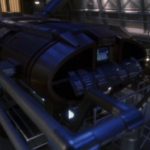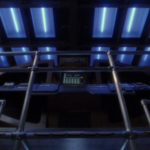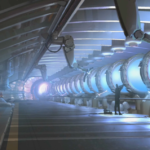This is where the vast majority of the carrier’s electrical energy comes from.
–
Table of Contents:
- Introduction
- Process
- Close vs. Far
- Build for Its Purpose
- Limitations
- 2023 September/+ Notes
- Conceptual Images
–
Introduction:
Being a kilometer+ long dreadnought-class war vessel, The New Horizon‘s (TNH) reactor room is more accurately a reactor district with relay and repeater modules evenly positioned throughout the stretch of the ship. The core houses the main ‘battery’ and its attached work stations. The relay stations elsewhere in the ship are smaller modules with fewer work stations.
–
Process:
The reactor utilizes cold fusion and fission of photons and subatomic particles to produce various forms of power for all of The New Horizon’s systems, including ammunition for its spectrum cannons (though they come pre-filled for weeks of prolonged combat). A breach of the reactor would trigger an automatic instant shutdown due to the way its structure is designed; there would be no need to manually intervene. Radiation poisoning is also a thing of the past; the reactor processes are so much more miniaturized and better contained, compared to in the early years of this technology.
–
Close vs. Far:
The New Horizon is a starship which predominantly uses a relative-FTL drive containing ‘Eezo‘ (not the dilithium crystals which most Starfleet drives were based around) to traverse the distances between star systems, while very seldom also utilizing Mass Relays for more timely travel between galactic arms.
Short/local ‘jumps’ (interplanetary and intra-stellar (between sub-systems in a multi-star system) travel) are performed using some of the energy from its reactor.
Longer ‘jumps’ (intragalactic travel) are usually performed with the assistance of the Mass Relays.
Longest ‘jump’s (intergalactic travel) are possible, but will consume a large portion of the reactor’s available output if not assisted by special Stargates or Webway channels.
–
Built for Its Purpose:
TNH is tasked with patrolling only the 34 Tauri multiple-star-system for the time being, with proposed patrols extending its route to several other stellar clusters in other arms of just the Milky Way galaxy. This means that it will never need the Mass Relays, and barely touch its potential power. In other words, its reactor has more than enough energy to handle all of its current duties.
–
Limitations:
Though built by Inisfreeans, TNH is kept low-tech’ (relative to Inisfree), meaning that only Inisfreeans can will it to pass through portals in the Inisfreean fashion; the ship itself does not have a drive or computer system capable of executing Inisfreean portal feats. Thus, TNH travel is not instantaneous; it takes something on the order of minutes to hours to traverse what any Inisfreean can move to within an instant. TNH can ‘jump’ within seconds of the command being issued, but may remain in-transit for minutes between star systems, and hours between arms of the Milky Way.
TNH’s reactor will provide steady power output the entire time during any jump, though longer jumps and simultaneous energy usage will require a ‘juggling’ of the overall reduction of potential operations. For example, if TNH is engaged in heavy combat, the energy used by its cannons, shields, tracking devices, and other sensors, may mean that faster or longer ‘jumps’ are not possible until it pauses or reduces some of those other functions. If it is mid-jump, it may not be able to use its longer-range sensors or all of its cannons at once. If it must defend itself while in a lengthy ‘jump’, it may be necessary to dim or turn off the lights and other power-consuming nodes across much or all of the ship.
* By comparison, Gray ships can pull energy from Space itself, and Inisfreean ships can pull energy from anything at all, thus they are much less likely to require a reduction or redistribution of any of their power. TNH is very advanced, but still requires reactor resupplies during RCOHs, and can theoretically end up adrift if left un-replenished for years at a time during frequent complex operations. It is a spacecraft meant for voyages between nearby worlds, not for Deep Space.
–
2023 September/+ Notes:
The starship NCC-1701-D Enterprise was 2,103′ “long” (deep), with nacelles ~814′ “long”.
TNH is ~4,000′ long, with a proportionately longer drive/engine; ~1,628′, separated into numerous sections, rooms, modules, etc., thus more of a district (subset of a city) than a hall or neighborhood; it is multiple neighborhoods / city-blocks worth of space in the carrier.
TNH does not use pulse-drives like Fireflies and most other 34 Tauri interplanetary vessels; it uses actual warp tech’.
Max safe speed: warp1; 670,616,629.384 mph
338.75 AU (the diameter of 34 Tauri) = 31,488,780,000 miles
TNH can go to the opposite side of 34 Tauri in 46.95496446 hrs; 1.956456852 days.
Thus the allotment of ~1 week for its (relatively) “long” jumps within this multi-system.
Since TNH was always destined to end up a gift to humans, it was not made of SRC; it is not invincible.
Persephone, however, always destined to stay one of my ships, was and is.
TNH usually travels at warp .5 (~.304 LS; 203,867,455.332736 mph) so normal (pulse-drive) UAP escort ships can keep up. This is why, while TNH can jump across all of 34 Tauri in <2 days, it “politely” and tactically spends a full week doing so.
Gravity in this carrier is also generated from the power here, some of the power from this reactor always directed to the in-floor gravity-generators built-in standard throughout this vessel.
–
–






